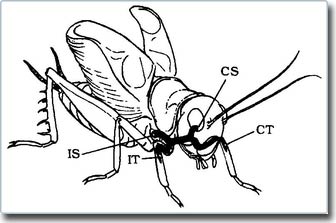How do animals identify sounds around?
Lisa Zyga
You are walking on a crowded street so crowded with cars that you almost don't hear anything. Suddenly someone called your name. You must turn 60 degrees to the left and look up at the second floor window of a building 100 meters away to determine the exact location of a friend waving.
According to scientists, people and other animals have the ability to identify sound sources relatively well. Since the early 1990s, many studies have explained the basic physical mechanism of animal ear phenomena that can determine the location of ' directional sound '.
In a recent study and review, scientists Axel Michelsen and Ole Naesbye Larsen of Southern Denmark University applied quantitative analysis methods of how some animals such as insects and small birds can determine the direction of the sound source. Although these animals cannot take advantage of the ' hints ' as humans do (the change in the direction of the sound and the time the sound reaches the human ear). However, the results of the study, published in the new issue of Bioinspiration and Biomimetics, also found important similarities for humans.

The crickets' ears are on their front legs and there are up to four sound reception parts.The first sound will come into contact with the outer eardrum with an ear canal, a horizontal tube and an opposite ear canal that will help sound to reach anywhere on the cricket body.(Photos: Michelsen and Larsen)
Michelsen told PhysOrg.com, 'We now understand the physical mechanism of the auditory system and can make quantitative predictions for conducting experiments'.
To determine where the sound comes from, animals can use information obtained from the ears (also called binaural signals) or information obtained from one ear (one-ear signal ). Michelsen and Larsen explain that many non-mammalian animals can calculate the azimuth of the sound source by using signals from the ears to receive sound from both inside and outside the eardrum. . This is called 'differential reception pressure'.
Birds and grasshoppers can apply different pressure to receive. This is reflected in the structure of their ears associated with a gas tube that runs throughout the body. When the sound runs between the ears, different sounds will vibrate the two eardrums. It is the inner and outer surfaces of the eardrum that help them identify the sound source. For example, which ear is directed towards the more sound source, the amplitude of vibration is greater than the ear is far from the sound source. According to the researchers, animals can locate sounds through sound transmission in the body and through signals from their ears.
Although scientists already know the mechanism of sound positioning in general but when conducting experiments in a convenient, unobstructed environment, the subject of experimentation is distracting. Michelsen and Larsen explain that scientists have not yet had access to a directed hearing mechanism, such as the transmission of sound in tubes in the body and the impact of habitats on the hearing of animals. object.
Michelsen said: 'Now we need to learn about the ability to listen to orientation in the natural environment where there are many trees that make the sound weak.'
In contrast, humans use a sound receptor that is different from animals. This agency simply applies receiving pressure. In the human ear only new external surfaces come into contact with sound. Ot-tat taps help balance the pressure between the ears but prevent the sound from entering the middle ear. People with normal hearing are able to identify surprising sound sources. People who use hearing aids can only locate sounds at a limited level.
But Michelsen and Larsen explain, using the technique of 'different reception pressure' like birds and grasshoppers can improve the sound positioning of hearing aids. They will be inserted into the ears, exchanging information through radio signals that increase the audio signal and help determine the timing more accurately in both ears. From there the user can locate the direction of the sound. As Michelsen says, this positioning is a necessary survival skill.

Praying Mantis (Photo: Soulpix.com)
He said: 'Mantis flying at night can hear the sound of bats hunting but cannot determine the direction of that bat. Therefore, the number of mantis being eaten by bats will be higher than in cases where the hearing of a mantis is equipped with different pressure reception techniques. '
There are still many mysteries about the ability to hear orientation in different animals. Frogs listen with lungs and mouth. Cricket has ears on the front leg just below its knees. Their hearing ability is extremely complex and so we can learn more about the amazing hearing abilities of nature.
- Can animals recognize them when looking at mirrors?
- Secrets of the sea: Sounds and sea creatures
- The world's largest vocal animals
- Why are you angry when the next person chews?
- Animal Language Translation Machine
- Out of soul with strange sounds from the ice lake in Siberia
- Be quiet, if you hear uu in your ears, this is why
- 'Singing' from Antarctica will be the sound that haunts you most today
- Video: Unusual screeching NASA probe collected in space
- NASA announces creepy sound from space right on Halloween
- For the first time, robots create sounds that have never appeared before
- Space earthquake signaled the end of the world?
 Animal 'suffering' after hibernation
Animal 'suffering' after hibernation Why do goats climb well?
Why do goats climb well? Scientists were surprised to see chimpanzees eating turtles
Scientists were surprised to see chimpanzees eating turtles Giant catfish died deadly due to drought in Thailand
Giant catfish died deadly due to drought in Thailand